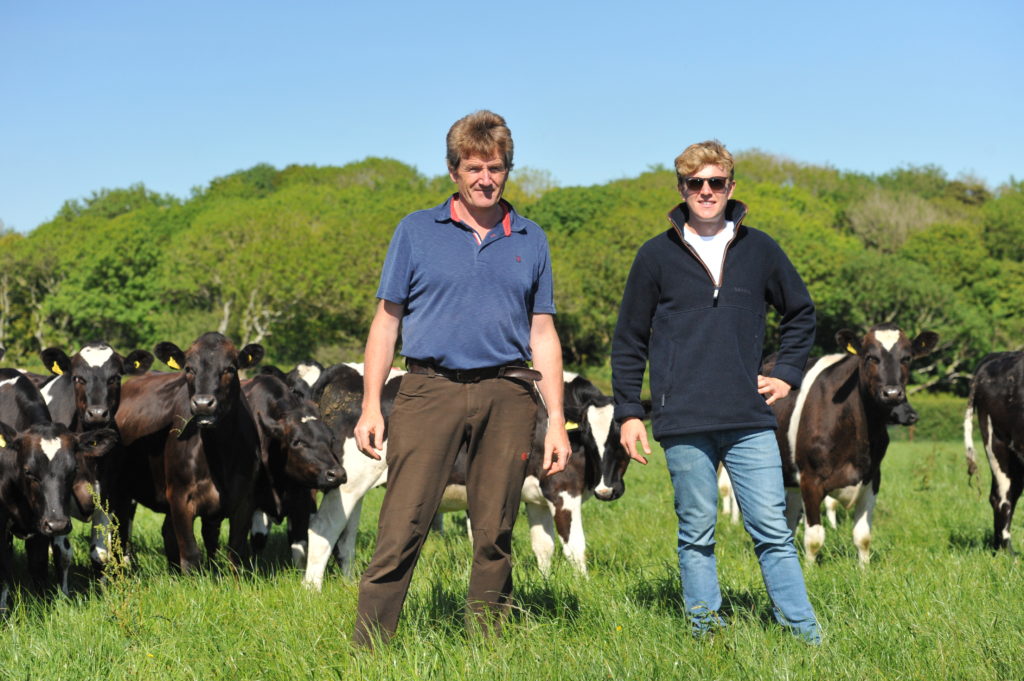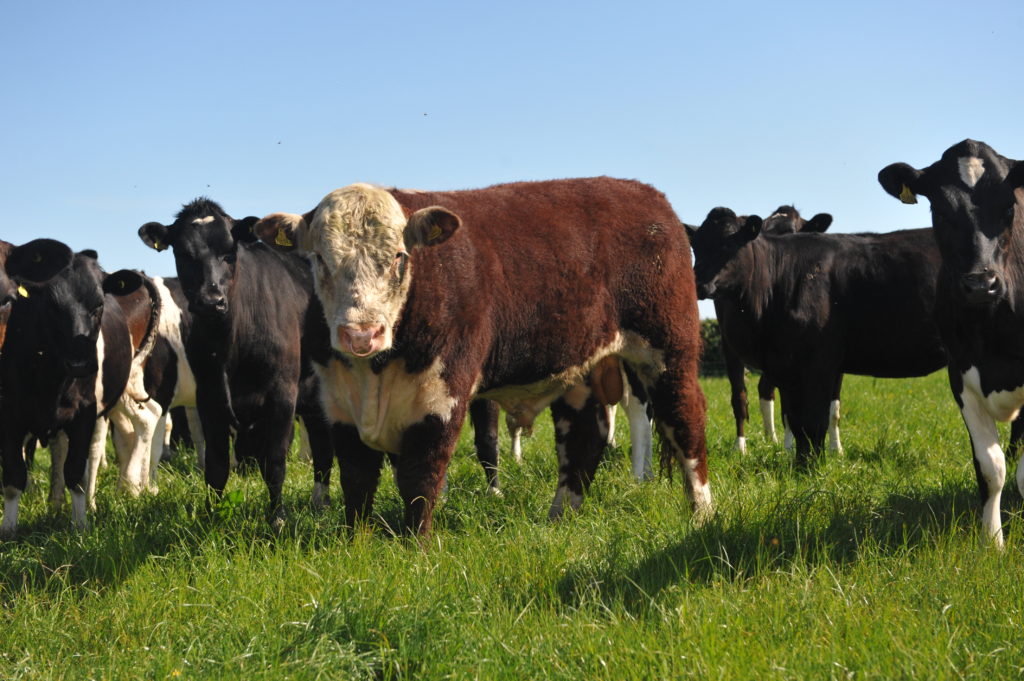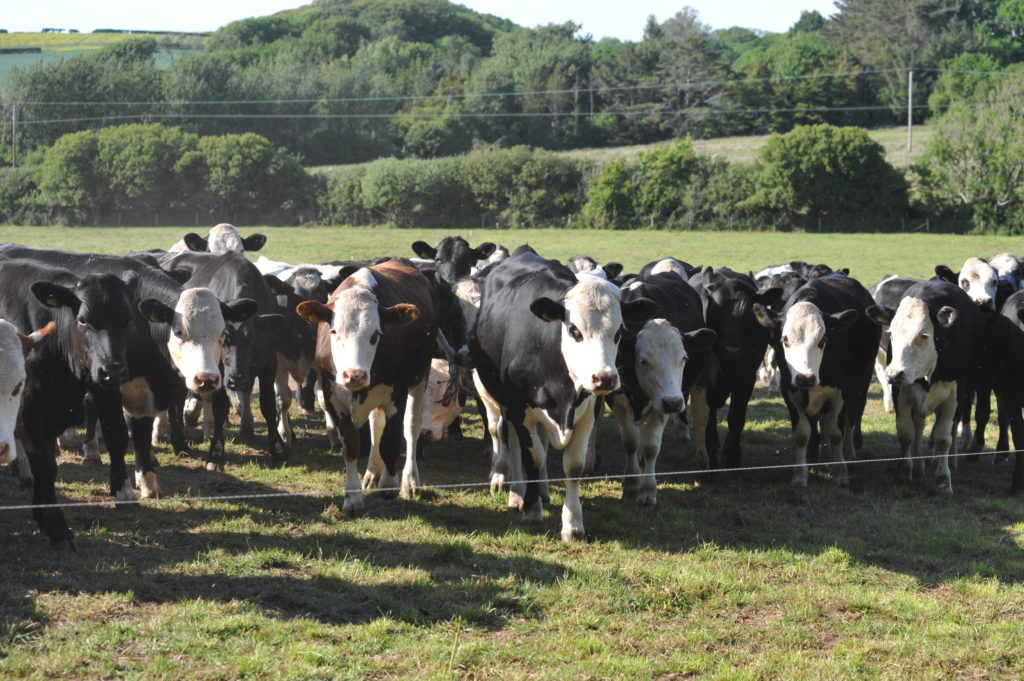
Calving 1,150 cows in nine weeks is an ambitious undertaking but as one of the earlier adopters of grass-based block calving milk production, Chris James has had two decades to refine the system.
Chris converted the two herds at Stackpole Home Farm and Stackpole Quay to spring-calving in 1999 – until then the estate had been run as a typical mixed farm since the family took it on in 1980, with dairying at its core.
The soil is free draining limestone and red sandstone and the farm is coastal so benefits from a maritime climate.
“It’s the ideal grassland farm for extended grazing because of its free draining soils and extended growth,’’ says Chris, who farms with his son, George.

Chris and George James
The principal aim is to produce as much milk as possible from grass in the grazing season and to outwinter on deferred grazing or forage crops.
Since 2010, beef production has added a new dimension to the business; the family bought a former beef farm with purpose-built facilities at nearby Warren and now rear all beef calves to sell as stores. Around 700 calves are reared annually and 350 of these are beef animals.
“We run the beef enterprise as an extension of the system we have for our dairy herd, to the same grazing principles,’’ Chris explains.
Initially, the breeding policy was to select continental beef sires to produce progeny from the herd of New Zealand-bred Friesians and Jersey-cross cows but the offspring weren’t best suited to the system. The emphasis has now switched to native breed sires, leading to the Hereford and Aberdeen Angus becoming the breeds of choice.
With the mature weight of the cow type in the herd averaging 550kg, heifers are served at 15 months at a target of 300kg.
To detect heats, tail heads are painted on 1 April and any animals that haven’t exhibited heat in the first three weeks are checked by a vet and observed daily. All AI is done in-house by Chris, George and trained members of staff. Heifers are served to a dairy bull for the first four weeks and after that first service they run with Hereford stock bulls.
Some sexed semen has been used this year to reduce the number of dairy bull calves born.
Cows are inseminated once to a dairy sire from 25 April followed by Hereford or Aberdeen Angus straws. Hereford bulls are used to sweep up cows that haven’t caught to service; an average of 1.6 straws are used per conception.
Fertility has been exceptional this year with a submission rate of 94 per cent in the first three weeks and a non-return rate of 65 per cent to first service. Good fertility, says Chris, relies on a matrix of doing everything well.
“It is how well trained your AI operators are, how much straw you use in the calving sheds to prevent uterine infections, how easy calving your bulls are, how good your post-calving protocols are.’’
Nine Hereford stock bulls were bought at the Hereford Cattle Society’s Sires of the Future sale in Shrewsbury in February. All were bought solely off EBV figures, says Chris.
“We are always keen to know their breeding and ancestry and to have very accurate EBVs for calving ease.
“We wanted the bulls to have good performance indices but focused heavily on calving ease scores because in a block calving system ease of calving in very important, so they have to have high accuracy EBVs for calving ease.
“If we wanted thumping calves we would breed to a double-muscled breed like the Limousin.
All bulls must be poll, and Chris says it is one less job. And they are purchased young, at around a year old, because bulls can’t be heavy if they are serving heifers from smaller dairy breeds.
“A lot of the bulls that are reared for the market are too strong for us, we like to buy them young and to only feed them forage, not concentrates, so they reach their full potential size and weight gradually,’’ Chris adds.
Incoming bulls are quarantined for eight weeks as the herd at Stackpole is BVD free; all are sourced from CHECS-accredited high health status herds.
The Hereford bull produces stock which are easy to manage, says Chris. “They are good to handle and to train to graze behind an electric fence.’’
The dairy herd is dried off throughout December, starting with the low yielders, and housed or out-wintered on kale.
Calving gets underway on 1 February and in 2020 70 per cent of the herd calved in the first three weeks, and all within nine weeks.
Depending on the weather, fresh calvers are mostly turned out to grass after their first milking, to grass covers of between 2,600 – 3,000kg dry matter (DM)/hectare(ha).
Calves receive three litres of colostrum within 12 hours of birth.
“Herefords are such vigorous sucklers that they all seem to suckle their mothers well but we like to drench the calves with colostrum as soon as they are born,’’ says Chris.
“When we start calving, the calves from the first cycle of dairy AI are quite sleepy but by the time we get halfway through and the Herefords start to arrive it is all we can do to catch them in the mornings.’’

The Hereford stamps its progeny well, he says. “You always know when a calf is a Hereford cross.’’
Cleanliness is the single most important element of calf rearing, he adds.
“You need good husbandry and protocols, it is about being organised because in a block calving system once you start you can’t change course.’’
Bull calves are castrated by applying rubber rings at birth and all calves are vaccinated for blackleg.
Cows’ milk is fed for the first three weeks of life after which rearing is on a once-a-day milk replacer system.
Weaning is at 80kg, when calves are eating 2kg of concentrates. After weaning they remain housed for up to two weeks, to allow them to settle, and are then turned out to grass if the weather allows, mostly in mid-April when they are aged 10 weeks or older.
At grass, concentrates are fed through a snacker – this feed is important as it includes a non-antibiotic medication for the control of coccidiosis.
Growth in the first five months is important, says George. “We try to get as much growth as we can in the first five months, we aim for an average daily liveweight gain of 0.8kg from birth, from the beef and the dairy replacements.’’
Youngstock are weighed monthly and this flags up any health issues, he points out. “It also allows us to group animals evenly, we don’t want small cattle grazing with big cattle.’’
Youngstock are run in groups of 120, grazing a fresh block every two days, George explains.
“The system we have for rotational grazing is the most efficient way of using our grass, it is where native breeds like the Hereford do so well.’’
Consistency of grass quality is very important, he adds.
“The skill with rearing calves at that age is to get the right quality grass in front of them, to turn them into covers of 2,800kgDM/ha every time they have a fresh break.’’
To achieve that, grass is measured weekly with a rising plate meter. This is vital because with so many groups on the rearing platform, recording is needed to manage grass and to budget feed.
Grouping according to size is also important at housing. Cattle are housed from November to late January, in groups according to weight. The lighter groups are fed cake if needed to maintain growth rates, with the quantity dictated by how they have grown, says George.
“We like to house at 200kg, if they are not there, they are fed up to 2kg of concentrates a head.’’
Weight also dictates turnout, he adds. “We have to turn a proportion out in late January, to make way for the next season’s calves.’’
Those that have hit target weights are turned out to forage crops – 40 acres of kale have been planted this year – or onto deferred grazing.
“The Hereford is particularly good at converting those crops into growth,’’ says George.
After those crops have been consumed, the cattle are turned out to grass on 48 hour grazing breaks in their second season.
In that second summer and through the autumn, the cattle are sold as stores at local markets, at a target weight of 520kg at 18 months for steers and 500kg for heifers.
“We sell most of the cattle as stores because it doesn’t pay to drive feed to the animal in remote regions like west Wales,’’ says Chris.
With dairy crosses, size is everything, he suggests.
“People talk about conformation but time and time again our buyers are surprised at the size of our stores because our cow type is small.’’
The stores are easy finishing because they have been produced by a grazing-type cow, he says, adding, they are good foragers, like their cows.
The Hereford will remain the James’ bull of choice going forward.
“Our breeding gives us a very good grazing animal and when crossed with a native breed like the Hereford we get very easy to manage beef crosses,’’ says Chris.
“One of the most enjoyable aspects of the job is selecting the bulls and rearing the calves and watching them grow on our farm.’’
The future for producing beef in grassland systems is good, he believes.
He says: “The consumer is appreciating the grass-fed animal, hopefully the market will allow us to differentiate more in the future.’’
Farm facts
640ha (1,581ac) across five sites – 40 per cent owned
Two milking parlours: 50 point rotary and 40 point swingover herringbone
Nine full time staff
1,150 milking cows yielding an annual average of 5,500 litres/cow at 4.8 per cent butterfat and 4 per cent protein
Milk sold to Dairy Partners
350 heifer replacements reared annually
“You have got to have easy calving animals on small dairy cows and the Hereford is giving us that.”